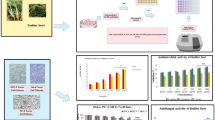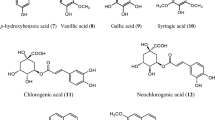Abstract
Methanolic extracts of 20 medicinal plants were screened at 1–10 mg/ml for in vitro macrofilaricidal activity by worm motility assay against adult Setaria digitata, the cattle filarial worm. Four plant extracts showed macrofilaricidal activity by worm motility at concentrations below 4 mg/ml and an incubation period of 100 min. Complete inhibition of worm motility and subsequent mortality was observed at 3, 2, 1 and 1 mg/ml, respectively, for Centratherum anthelminticum, Cedrus deodara, Sphaeranthus indicus and Ricinus communis. 3-[4,5-dimethylthiazol-2-yl]-2,5-diphenyl tetrazolium bromide (MTT) reduction assay was carried out at 1 mg ml−1 and 4-h incubation period, and the results showed that C. deodara, R. communis, S. indicus and C. anthelminticum exhibited 86.56, 72.39, 61.20 and 43.15% inhibition respectively in formazan formation compared to the control.
Similar content being viewed by others
References
Alvarez Montes de Oca DM, de la Fuente JL, Villarrubia Montes de Oca OL, Menendez de San Pedro C, Losada EO (1996) The biological activity of Ricinus communis on the housefly (Musca domestica). Rev Cuba Med Trop 48(3):192–194
Avery MA, McLean G, Edwards G, Ager A (2000) Structure activity relationships of peroxide based artemisinin antimalarials. In: Cutler SJ, Cutler HG (eds) Biologically active natural products: pharmaceuticals. CRC, Boca Raton pp 121–132
Comley JCW, Rees MJ, Turner CH, Jenkins DC (1989a) Colorimetric quantitation of filarial viability. Int J Parasitol 19(1):77–83
Comley JCW, Townson S, Rees MJ, Dobinson A (1989b) The further application of MTT-formazan colorimetry to studies on filarial worm viability. Trop Med Parasitol 40:311–316
Ferraz AC, Angelucci ME, Da Costa ML, Batista IR, De Oliveira BH, Da Cunha C (1999) Pharmacological evaluation of ricinine, a central nervous system stimulant isolated from Ricinus communis. Pharmacol Biochem Behavior 63(3):367–375
Haynes RK, Vonwiller SC (1997) Qinghao marvelous herb of antiquity to the antimalarial trioxane Qinghaosu. Some remarkable new chemistry. Acc Chem Res 30:73
Jacobson RL, Schlein Y (1999) Lectins and toxins in the plant diet of Phlebotomus papatasi (Diptera: Psychodidae) can kill Leishmania major promastigotes in the sandfly and in culture. Ann Trop Med Parasitol 93(4):351–356
Kar K, Puri VN, Patnaik GK, Sur RN, Dhawan BN, Kulshrestha DK, Rastogi RP (1975) Spasmolytic constituents of Cedrus deodara (Roxb.) Loud: pharmacological evaluation of himachalol. J Pharm Sci 64(2):258–262
Kliks MM (1985) Studies on the traditional herb anhelmintic Chenopodium ambrosides L: ethanopharmacological evaluation and clinical field trials. Soc Sci Med 21:879–886
Lin JY, Liu SY (1986) Studies on the antitumor lectins isolated from the seeds of Ricinus communis (castor bean). Toxicon 24:757–765
Lindley D (1987) Merck’s new drug free to WHO for river blindness programme. Nature 329:752
Makonnen E, Zerihun L, Assefa G, Rostom AA (1999) Antifertility activity of Ricinus communis seed in female guinea pigs. East Afr Med J 76(6):335–337
Nisha M, Paily KP, Vanamail P, Abidha S, Kalyanasundaram M, Balaraman K (2002) Macrofilaricidal activity of the plant Plumbago indica/rosea in vitro. Drug Dev Res 56(1):33–39
Noroes J, Dreyer SA, Mendes VG, Medeiros Z, Addism D (1997) Assessment of the efficacy of diethylcarbamazine on adult Wuchereria bancrofti in vivo. Trans R Soc Trop Med Hyg 91:78–81
Ottesen EA, Duke BOL, Daram M, Behbehani K (1997) Strategies and tools for the control/elimination of lymphatic filariasis. Bull World Health Organ 75:491–503
Sharma S, Mehta BK (1991) In vitro antimicrobial efficacy of Centratherum anthelminticum seeds extracts. J Hyg Epidemiol Microbiol Immunol 35(2):157–161
Shekhani MS, Sham PM, Yasmin A, Siddiqui R, Perveen S, Khan KM, Kazmi SU, Rahman AU (1990) An immunostimulant sesquiterpene glycoside from Sphaeranthus indicus. Phytochem 29:2573–2576
Shinde UA, Phadke AS, Nair AM, Mungantiwar AA, Dikshit VJ, Saraf MN (1999a) Studies on the anti-inflammatory and analgesic activity of Cedrus deodara (Roxb.) Loud. wood oil. J Ethnopharmacol 65(1):21–27
Shinde UA, Phadke AS, Nair AM, Mungantiwar AA, Dikshit VJ, Saraf MN (1999b) Preliminary studies on the immunomodulatory activity of Cedrus deodara wood oil. Fitoterapia 70:333–339
Singh SK, Tripathi VJ, Singh AK, Singh RH (1988) An antimicrobial principle from Sphaeranthus indicus Linn. Int J Crude Drug Res 26(4):235–239
Singhal KC, Sharma S, Mehta BK (1992) Antifilarial activity of Centratherum anthelminticum seed extracts on Setaria cervi. Indian J Exp Biol 30(6):546–548
Strote G, Bonow I, Kromer M, Rubio de Kromer T, Attah S, Opoku N (1998) Chemotherapy for onchocerciasis: results of in vitro experiments with promising new compounds. Trop Med Int Health 3(5):397–407
Titanji VPK, Ayafor JF, Mulufi JP, Mbacham WF (1987) In vitro killing of Onchocerca volvulus (Filaroidea) adults and microfilariae by selected Cameroonian medicinal plant extracts. Fitoterapia 58(5):338–339
Tiwari AK, Srinivas PV, Kumar SP, Rao JM (2001) Free radical scavenging active components from Cedrus deodara. J Agric Food Chem 49(10):4642–4645
Vanamail P, Subramanian S, Das PK, Pani SP, Rajagopalan PK (1990) Estimation of fecundic life span of Wuchereria bancrofti from longitudinal study of human infection in an endemic area of Pondicherry (South India). Indian J Med Res 91:293–297
Varrier PK, Nambiar VPK, Ramankutty C (1995) Indian medicinal plants—a compendium of 500 species. Vol. 1–5, Oreint Longman, Madras, India
WHO (1997) Lymphatic filariasis elimination. Report of a meeting of the principals for further enhancement of public/private partnership, WHO, Geneva
Acknowledgements
Dr. Nisha Mathew expresses her sincere gratitude towards the International Foundation for Science (IFS) and the Organization for Prohibition of Chemical Weapons (OPWC), Stockholm, Sweden for the funding (Grant no. F/ 2929-1) to conduct this study.
The authors are grateful to Dr. P. K. Das, Director, Vector Control Research Centre for his encouragement during the study. The technical assistance rendered by Mrs. R. Anilakumari, Mr. S. Srinivasan and the staff of the parasitology division is gratefully acknowledged.
Author information
Authors and Affiliations
Corresponding author
Additional information
This research is supported by The International Foundation for Science (IFS) and Organization for Prohibition of Chemical Weapons (OPWC), Stockholm, Sweden through a Grant to Dr. Nisha Mathew (Grant No. F/2929-1).
Rights and permissions
About this article
Cite this article
Nisha, M., Kalyanasundaram, M., Paily, K.P. et al. In vitro screening of medicinal plant extracts for macrofilaricidal activity. Parasitol Res 100, 575–579 (2007). https://doi.org/10.1007/s00436-006-0294-9
Received:
Accepted:
Published:
Issue Date:
DOI: https://doi.org/10.1007/s00436-006-0294-9




